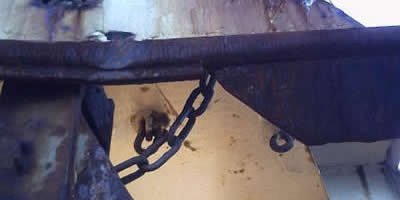Current Techniques
 The traditional ways to deal
with such problems are well known. Fatigue cracks in welds or panels usually involve renewal of part of the
weld, welding in the cracks in a panel or replacement of the whole parent panel itself. The standard way to
face heavy corrosion is also the replacement of the corroded structural members, whereas the use of bolted or
welded doubler plates seemed to be the only way until now to reinforce a structural part. There are
circumstances, however, when these repair or reinforcement approaches are either time-consuming and costly, or
simply impossible to be followed. A classical example is the condition where the whole structure is under
significant loading due to its own weight (especially tension) and therefore the use of any welding is
prohibitive. Cutting off and replacing a structural member is also out of question or necessitates a very
costly support of the structure. Conditions like this are quite often encountered in steel bridges or
bridge-type structures such as the big gantry cranes of the shipyards or other large port cranes. Regarding
this last application in particular, several problems are noticed nowadays, since there are several big-size
gantry cranes worldwide (many of them in Europe) approaching or having passed their initial fatigue life.
Another disadvantage of the traditional repair methods is that the execution of hot, sparking works associated
with welding in a highly explosive environment such as the ship holds (e.g. of a hydrocarbon tanker or of a
hazardous products cargo ship) and fuel tanks necessitates a very careful and complicated preparation and is
possible only under severe safety precautions. This in turn, can have a substantial effect on the cost of the
repair, since the ship can stay out of operation for a relatively long period. Finally, the design and
application of a bolted or welded doubler plate is not a very straightforward procedure, since all steps must be
taken very carefully, in order to avoid the introduction of new stress raisers.
The traditional ways to deal
with such problems are well known. Fatigue cracks in welds or panels usually involve renewal of part of the
weld, welding in the cracks in a panel or replacement of the whole parent panel itself. The standard way to
face heavy corrosion is also the replacement of the corroded structural members, whereas the use of bolted or
welded doubler plates seemed to be the only way until now to reinforce a structural part. There are
circumstances, however, when these repair or reinforcement approaches are either time-consuming and costly, or
simply impossible to be followed. A classical example is the condition where the whole structure is under
significant loading due to its own weight (especially tension) and therefore the use of any welding is
prohibitive. Cutting off and replacing a structural member is also out of question or necessitates a very
costly support of the structure. Conditions like this are quite often encountered in steel bridges or
bridge-type structures such as the big gantry cranes of the shipyards or other large port cranes. Regarding
this last application in particular, several problems are noticed nowadays, since there are several big-size
gantry cranes worldwide (many of them in Europe) approaching or having passed their initial fatigue life.
Another disadvantage of the traditional repair methods is that the execution of hot, sparking works associated
with welding in a highly explosive environment such as the ship holds (e.g. of a hydrocarbon tanker or of a
hazardous products cargo ship) and fuel tanks necessitates a very careful and complicated preparation and is
possible only under severe safety precautions. This in turn, can have a substantial effect on the cost of the
repair, since the ship can stay out of operation for a relatively long period. Finally, the design and
application of a bolted or welded doubler plate is not a very straightforward procedure, since all steps must be
taken very carefully, in order to avoid the introduction of new stress raisers.
All these disadvantages of the traditional repair and reinforcement methods obviate the need for investigating and assessing the effectiveness of new solutions that will help in overcoming the currently existing problems.
